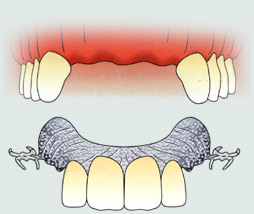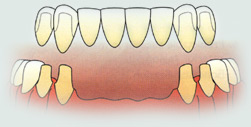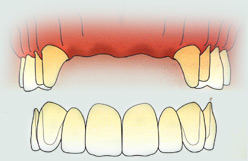 People who have lost or are missing multiple teeth whether from periodontal (gum) disease, tooth decay or injury, face unwanted changes over a period of time.
These challenges include aesthetic difficulties if front teeth are missing and chewing difficulty if back teeth are missing. Neighbouring teeth and teeth in the opposite jaw may drift in to the space where the teeth are missing.
People who have lost or are missing multiple teeth whether from periodontal (gum) disease, tooth decay or injury, face unwanted changes over a period of time.
These challenges include aesthetic difficulties if front teeth are missing and chewing difficulty if back teeth are missing. Neighbouring teeth and teeth in the opposite jaw may drift in to the space where the teeth are missing.
These considerations lead to further compromise in the remaining dentition and may also lead to further tooth loss.
The most serious of these problems is the loss of underlying jaw bone, for without the support of this foundation dental treatment becomes compromised.
Treatment for Patients missing Multiple Teeth
Replacing the Missing teeth and preserving remaining Teeth
 Removable Partial Denture (Partial)
Removable Partial Denture (Partial)
A removable partial denture is a prosthesis that replaces missing gum tissue and teeth. It is made of metal and acrylic.
The advantages of this treatment include that the expense of treatment relatively low. Teeth are stabilized from drift and movement. Treatment time is relatively short.
Treatment time is relatively short.
Disadvantages include that the prosthesis may show in the smile.
There is a risk of tooth decay, gum tissue irritation and continued bone resorption where the prosthesis rests.
 Fixed Partial Denture (Bridge)
Fixed Partial Denture (Bridge)
A fixed partial denture is also commonly referred to as a bridge. The prosthesis is made of metal or metal and porcelain.This procedure involves preparing or reshaping the teeth on either side of the missing teeth. The prosthesis is then cemented over the prepared teeth. An advantage of this technique is that it is relatively expedient. The bridge will stabilize the bite and prevent movement of the opposing teeth. A bridge is aesthetically pleasing and functions well.
 Disadvantages of this treatment are:
Disadvantages of this treatment are:
- Good teeth have to be cut or ground down
- Two or more teeth are used to support a number of missing teeth
- There is the risk of nerve damage to the teeth being ground down
- Future decay could occur around the supporting teeth
- Future decay could start on the neighbouring teeth
- Porcelain could fracture
- Limited life span.
 Implant Supported Fixed Partial Denture (Implant Bridge)
Implant Supported Fixed Partial Denture (Implant Bridge)
An implant supported bridge replaces missing teeth. It is held in place by two or more implants that are anchored in the jawbone.
Advantages:
- No preparation or reshaping of the remaining teeth is required
- Reduces the risk of decay
- No tooth nerve-damage
- No gum tissue irritation to the remaining teeth
- Helps support the underlying bone and greatly reduces bone loss (melting away)
- Can be phased in to make it more affordable
- Natural biting and chewing capacity is restored
- The integrity of the facial structures is maintained
- They look feel and function like natural teeth
- They are much more comfortable and stable than partial dentures
 Disadvantages:
Disadvantages:
- Initial more expensive than other options
- The teeth may suffer the same unwanted complications as with conventional treatment since the materials are same.
- Requires a simple surgical procedure if done expediently at the time of tooth loss or shortly after.
Studies have shown that implants placed more than 25 years ago have had a 90% success rate. Implants supporting multiple missing teeth have shown similar success rates. Unfortunately patients do not complain of functional and cosmetic problems initially because these changes occur very slowly.
The three common treatment options are:
- Traditional tooth supported bridge
- A removable partial denture
- Implant supported bridge
A removable prosthesis, such as a partial denture, actually accelerates the bone resorption process, resulting in more rapid bone deterioration. In addition, the clasps which hold the partial denture in place put extreme pressure on the natural teeth they hook onto, loosening them and in many cases, eventually leading to the loss of those teeth.
Most patients with partial dentures state that they are uncomfortable and that they rarely wear them.
 Or Call: 519-258-6722
Or Call: 519-258-6722
 Or Call: 519-258-6722
Or Call: 519-258-6722